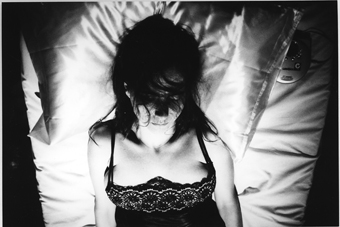Deborah Pollard: The art of sleeping
Marie-Anne Mancioon repose as installation

Deborah Pollard, Shapes of Sleep
photo Dobrilla Stamenkovic
Deborah Pollard, Shapes of Sleep
Representations of sleep in Western culture tend to emphasise its proximity to death (consider Perrault’s Sleeping Beauty or the “sleeping sickness” investigated by Oliver Sacks and dramatised by Harold Pinter in A Kind of Alaska). Deborah Pollard focuses instead on sleep as an activity. Over a period of 8 hours—the length of a typical night’s sleep—5 performers in nightwear lie on individual beds listening to recorded voices: “Put both hands on your neck…. Turn to the right…..Sit bolt upright…” There is a nice comic moment when the performers are directed to mutter: “No, it doesn’t matter. None of it matters anymore.” These simple instructions relate to video documentation of sleepers (the original footage appears on a miniature bed in the space). The movements appear to derive from a restless night in a hot climate. We can make out individual voices and sounds of birdsong, a cockerel’s faint crow, playing on a loop. On the far wall is a row of little embroidered pillows decorated with video stills.
Other artists have explored the process of filming themselves in certain states then recreating their actions in performance (the Wooster Group did it with drugs, Forced Entertainment with alcohol). The fascination is the same: what do we look like when we lose control? Some viewers are drawn to the back of the space, walking between the beds, looking down on the sleepers. A man stands too close to the dark-haired girl’s bed; I suddenly realise how vulnerable she is (not surprising that Cornelia Parker’s 1995 The Maybe installation placed sleeping Tilda Swinton in a glass case). Other viewers relax into the work, noticing how each performer interprets the same instructions slightly differently. I look for signs of tiredness or cunning (someone anticipating a command in order to gain as much time as possible in one position). If Shapes of Sleep were an hour long, it might appear choreographed, but as a durational installation over 8 hours the performers are no longer just performing sleep, they are physically exhausted by it. It’s a witty reversal of the notion of sleep as something that revives. Since the performers have their eyes closed throughout, it’s not surprising that one of them drifts off for a few minutes. I become infected by the hypnotic repetition, start to yawn, not out of boredom but tiredness.
Shapes of Sleep was conceived for a white space like the airy mezzanine of Glasgow’s Tramway where I first saw it. I agree with Deborah Pollard that in the Dark Studio at Arnolfini the work looks “more theatrical” (the connection between sleep and darkness is too obvious; the minute white pillows more blatant.) Nevertheless, the peculiar beauty of this work is undiminished. The soft light throws shadows on silk pyjamas; arms and legs shift languidly. By the final hour, there is a haze to the space; it even smells of people sleeping. At the end of a hectic festival, I cannot imagine a more effective oasis of tranquillity.
Deborah Pollard trained in the Suzuki Actor Training Method, has collaborated with Indonesian performance and installation artists, and was Artistic Director of Salamanca Theatre Company in Hobart, Tasmania, 1997-2000.
Shapes of Sleep, Deborah Pollard, Arnolfini Dark Studio, Feb 5
RealTime issue #72 April-May 2006 pg.






